The National Gallery of Canada is the largest art museum in the land and, as such, is a major cultural and tourism hub not only in the city but in the whole country.
With its vast array of collections, featuring (among other things) Canadian, Indigenous, European, modern, and contemporary art, it’s a must-visit for any art lover or traveler.
In this article, come explore this museum with me, and learn more about why I think it’s a great place to dive into the world of art.
Whether you love traditional Canadian paintings or you’re enamored with internationally acclaimed contemporary works, you will have a great time at the National Gallery of Canada.

Why Visit the National Gallery of Canada
See Iconic Canadian and Indigenous Artworks
When you go to the National Gallery of Canada, you get to see some of the most iconic Canadian art.
The museum is filled with artwork that shows the past and present of Canada.
There are beautiful works by the Group of Seven, a group of artists who painted the country’s landscapes with great color. It’s a nice tour through Canada’s varied art scene.
Enjoy World-Class European and Contemporary Art Collections
If you love European art, then you’re going to be right at home at the National Gallery of Canada.
There are works here by some of the most famous artists in the world that will just blow you away.
From the masterpieces by the greatest impressionists to the more jarring modern art, you’ll find what you’re looking for.
This gallery gives you a little taste of Europe’s best.
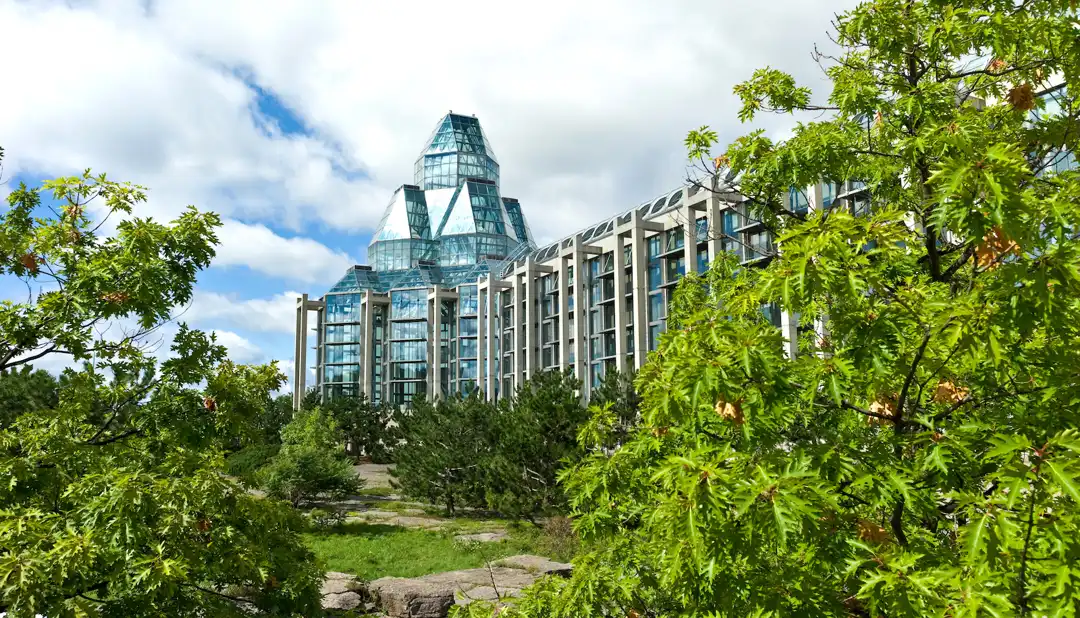
Conveniently Located Near Ottawa Landmarks
The National Gallery of Canada is close to Parliament Hill and the Rideau Canal, so if you’re visiting those locations, you can easily add a stop here.
You can really make a day of it: tour Parliament, stroll the canal, and then check out some art.
Since there is so much in the neighborhood to keep you busy, it’s a great place to spend a day if you’re a museum fan or a visitor to the city.
Practical Information
Here’s everything you need to know before you go to the National Gallery of Canada:
History of the National Gallery of Canada
Founded in 1880, the National Gallery of Canada was created to promote art and build a collection reflecting the nation’s heritage.
As its holdings grew, the gallery evolved into more than a museum—it became a symbol of Canada’s cultural identity. By preserving and showcasing art, it has played a major role in shaping the country’s cultural landscape.
Over time, the collection expanded to include Canadian and Indigenous works, offering visitors a vivid look at the nation’s history and creativity.
From modest beginnings, it grew into a respected institution with national and international influence.
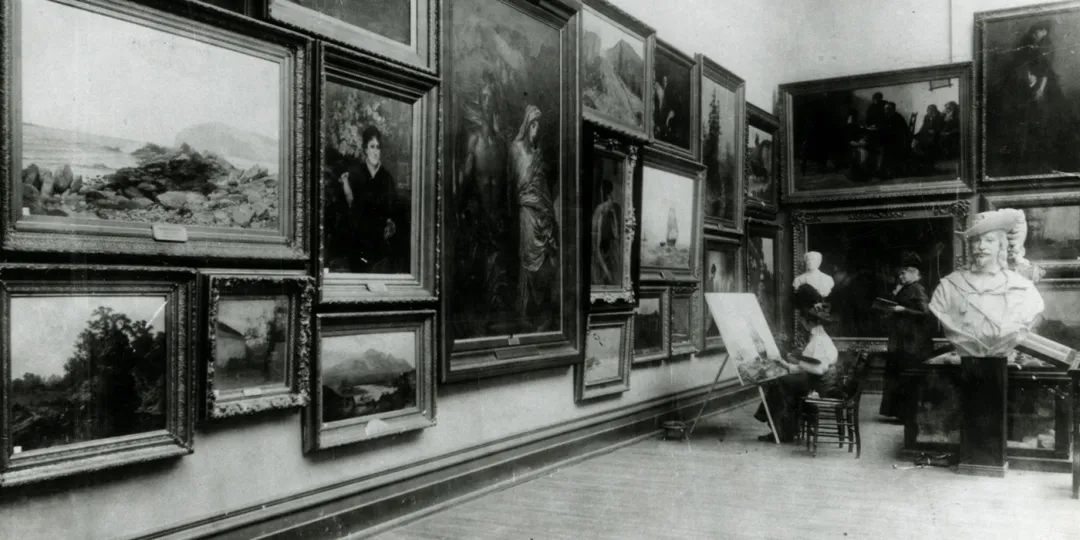
Location and Address
Address: 380 Sussex Drive, Ottawa, Ontario, Canada
Centrally located near Parliament Hill and the ByWard Market.
Opening Hours and Days of Operation
Tuesday to Sunday: 10:00 AM – 5:00 PM
Thursday: Extended hours until 8:00 PM
Monday: Closed (except some holiday Mondays)
Closed on December 25 and January 1.
Ticket Prices and Discounts
Adults: around $20 CAD
Seniors (65+): discounted rates (~$18 CAD)
Students (with valid ID): discounted rates (~$10 CAD)
Youth under 18: Free admission
Special pricing for groups and exhibitions may apply.
Accessibility Options
Wheelchair Accessible: The entire building, including galleries, washrooms, and entrances, is wheelchair accessible.
Elevators & Ramps: Elevators and ramps are available for easy movement between floors.
Accessible Parking: Designated parking spaces close to entrances.
Support Services: Complimentary wheelchairs available on-site.

Canadian Art
Visiting the Canada art section at the National Gallery of Canada is a vibrant tour of the country’s story.
Here, they show just how frisky and inventive Canadian art can be.
This gallery includes some of the most famous works by the Group of Seven and the legendary Emily Carr.
Both created stunning pieces that captured the landscape and stories of the nation.
Group of Seven
The Group of Seven is celebrated for its colorful and emotive portrayal of the Canadian landscape.
This selection features some of the most iconic pieces that will help you get a sense of their style and vision.
1. A.Y. Jackson – Hills, Killarney, Ontario (c. 1933)
In his “Hills, Killarney, Ontario”, he knew how to present the rugged landscape of one of his favorite Canadian landscapes.
It’s painted in bright hues and with visibly rapid brushstrokes, so you can feel the hills spring to life.
It’s a lively painting that will make you appreciate Canada’s vast and untamed wilds.
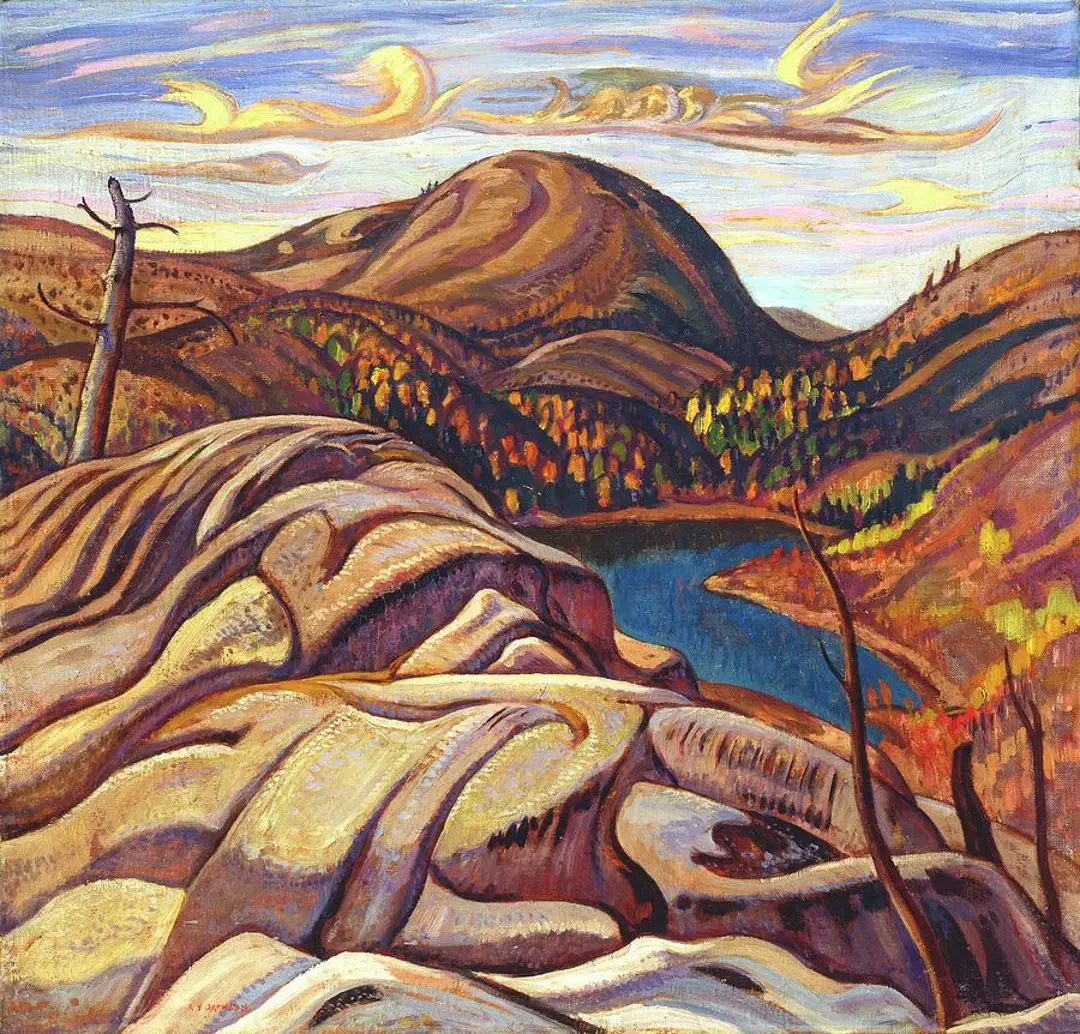
2. Franklin Carmichael – Autumn in Algoma (1920)
Franklin Carmichael’s “Autumn in Algoma” pays homage to the dazzling autumn foliage found in the Algoma District of Ontario.
The painting is a symphony of reds, oranges, and yellows typical of fall in Canada.
Carmichael’s bond with the wilderness is clear, using the scene at hand to create a powerful piece of art.
It’s a striking representation of both the transient nature of autumn and the Canadian terrain.
3. Lawren Harris – Lake and Mountains (1926)
“Lake and Mountains,” by Lawren Harris, depicts a peaceful landscape of the Canadian Rockies.
Harris was intensely interested in the spiritual quality of the land he was painting, and this work reflects that interpretation.
The monumental mountains tower over the calm lake, offering a feeling of solitude and introspection.

Emily Carr
Emily Carr (1871–1945) was a Canadian artist best known for her scenes of the forests of the Pacific Northwest.
Carr’s work is distinctive for its combination of the influences of the indigenous cultures of the Pacific Northwest and the Post-Impressionists.
1. Blue Sky (1936)
“Blue Sky” by Emily Carr is a delightful painting that looks up at the sky.
The brushwork gives the impression of swirling clouds, abstract but convincing, while the large surrounding blue indeed makes up most of the painting.
Carr does a great job of examining the high and low points of the sky, encouraging the viewer to gaze so as to see its true size.
2. Odds and Ends (1939)
“Odds and Ends” by Emily Carr features a disparate group of objects, capturing the textures and shapes of the mundane.
The artwork is dominated by warm colors and Carr’s finely-detailed brushstrokes, which give all of the objects on the canvas presence and energy.

Indigenous Art
Visiting the National Gallery of Canada Indigenous art wing is like exploring a world of rich and vibrant tradition that seamlessly merges with the modern and contemporary.
From centuries-old works to works that incorporate modern mixed media, a visit to this gallery is a lesson in appreciating how Indigenous art changes over time while staying true to its roots.
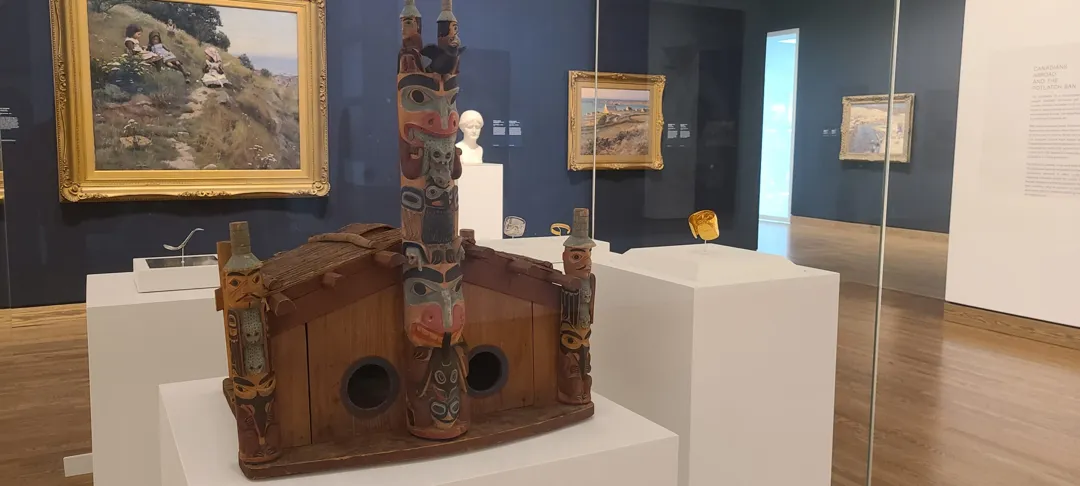
1. Haida Argillite Carving – Model Totem Pole (c. 1870)
The Haida Argillite Carving, a small totem pole created around 1870, is an outstanding example of Haida art.
This totem pole was hand carved by an unknown artist and used as a piece of currency to purchase furs and pelts.
The use of argillite (a rare black slate) carvings were very popular and could be found frequently with Europeans carvers.
2. Carl Beam – The North American Iceberg (1985)
Carl Beam’s “The North American Iceberg” is a mixed-media work that forces viewers to question the historical and personal narratives they have long held.
It combines images and symbolism in a way that sheds light on the clash of Indigenous and Western societies.
Beam has a knack for presenting elaborate concepts in an accessible photo. With this work, he tells hidden stories, probing the tales that have been widely accepted.
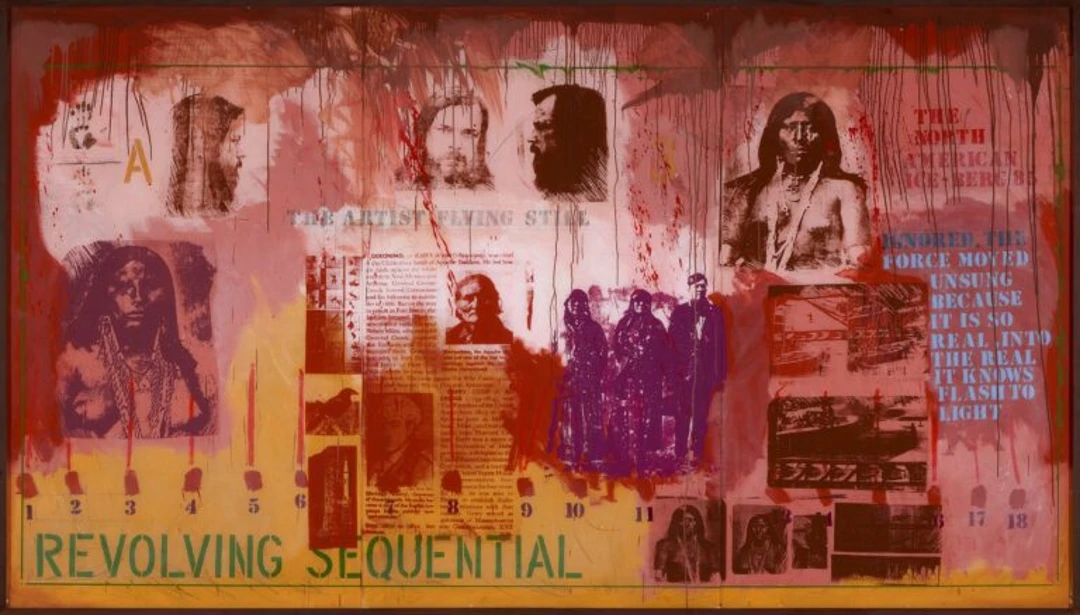
3. Beadwork by Indigenous Artists
The beadwork on show is truly amazing and speaks to the artistic traditions and creativity of Indigenous nations.
Modern works, such as those found in exhibits such as “Radical Stitch,” further illustrate the ability of bead work to function both as a traditional art form and as contemporary means of art expression.
Each piece features a range of colors and design, while also telling the story of the artist’s culture and life.

European Art
But, once you enter the European Art wing, be prepared to be amazed.
Perhaps the greatest attraction to the European side of the National Gallery of Canada though is its spectacular European Art collection.
You’ll get to see works of some of the most famous artists in the world, most who deeply shaped the view of art in the world as a whole.

1. Jean-François Millet – L’Angelus (1857–59)
Jean-François Millet’s “L’Angelus”is a beautiful, moving piece that depicts farm life during his era.
Both peasants have paused their labor to pray, offering a glimpse into a rare moment of peace and devotion.
Millet is so good at painting details that you feel yourself transported there, feeling the evening’s cool as well as the agricultural devotion.
2. Claude Monet – Waterloo Bridge: Effect of Sunlight in the Fog (1903)
Claude Monet was a master of light and atmosphere. You can see it clearly in his painting of London’s Waterloo Bridge.
The way he captures the light and the mist here makes the painting seem otherworldly.
His soft brush strokes and the painting’s pale colors also create a sense of dreaminess, making you step in to explore further.
3. Paul Cézanne – Large Bathers (c. 1898)
Cézanne’s “Large Bathers” is a significant departure from the traditional theme of the bathers—a remarkable example of how Cézanne experimented both with form and with color.
The painting is a strange one that that titillates for its bizarre composition and also the richness of the contrasted colors.
The bathers in Cézanne’s painting have nearly no specific boundaries; they merge directly into the landscape, pulling the work together in one complete whole.
It’s the kind of scene that’s almost impossible to take in all at once, and the eye continually moves around, seeking out the balance of complex and simple.

Modern and Contemporary Art
The area of the National Gallery of Canada that will likely intrigue you the most is the Modern and Contemporary Art wing.
It’s where you’ll find the most boundary-pushing art and the artists who think outside of the box.
Step into this section and you’ll be met with a mixture of different styles and traditions.
Every artwork in here was created for a reason and offers a look into the hows and whys of today’s world.

1. Brian Jungen – Prototype for New Understanding (2005)
Brian Jungen’s “Prototype for New Understanding” explores consumerism and cultural identity through unconventional sculptures.
Jungen has a way of using everyday materials in wholly inventive ways, incorporating questions about cultural stereotypes into his art.
His pieces uncover issues surrounding sustainability and the deceptiveness of identity in a globalized society.

2. Rodney Graham – Vexation Island (2006)
Rodney Graham’s “Vexation Island” is a photograph that blurs the line between historical reference and modern narrative.
With this multifaceted work, Graham sets up an experience meant to engage the viewer’s attention.
It could almost be a movie scene, with elements of surrealism and levity infused into it.
It’s a journey that spans decades, merging antiquity with contemporary in a form only Graham could create.

3. Ian Wallace – The Fall (2009)
Ian Wallace’s “The Fall” is an oversize photograph that explores art, history, and memory.
It holds an intimate and epic story that considers memory as a visual narrative.
Wallace forces you to think about how history is encountered and remembered, through art and images.
The longer you stare, the more you’ll ponder the passage of time and how history both collective and personal is altered.

4. Geoffrey Farmer – The Surgeon and the Photographer (2011)
“The Surgeon and the Photographer,” an installation work by Geoffrey Farmer, is absolutely amazing.
This one is made up of thousands of images that he cut out from various books and magazines and reassembled as a gigantic collage.
It’s as if you walk into a room that just tells stories of changes and self-discovery through images.
When you look at Farmer’s work, you also wonder about the role of the visual media in our lives and how we see the world and events around us.
Visiting Tips for Visitors
Plan Ahead
Before you go to the National Gallery of Canada, I recommend visiting their website.
Not only can you learn when the museum is open, but what, if any, special exhibitions are going on when you are there.
Photography & Etiquette
Yes, you can take photos, but be sure to look for signs in each room. Some have rules and flash photography is always prohibited.
By keeping a good distance from the paintings, you’ll preserve them for future generations.
Guided Tours & Audio Guides
If you’d like to learn more about the history behind the works, the gallery has audio guides that give you a personal guide in your ear.
They come in various languages and allow you to take in the display at your leisure while offering some interesting information.
The tour groups are another good way to find out more and see things you might not have seen on your own.
Dining & Breaks
The National Gallery of Canada has an on-site café and restaurant, the perfect spot to sit back and unwind.
Whether you just want a speedy coffee or a more drawn-out dining experience, you’ll find what you need.

FAQ
1. How long should I visit the National Gallery of Canada?
Most travelers are in and out in 2-3 hours but if you’re an art lover, around four hours.
2. Do any other museums partner with the National Gallery of Canada?
Yes. As well as hosting temporary exhibitions and loaning works globally, the Gallery collaborates with institutions.
3. Is parking available at the Gallery?
Yes, there is paid underground parking and some street parking.
4. Can teachers or schools arrange educational visits?
Yes. School programs and workshops are available at The Gallery, which are designed to enhance art, history, and cultural studies curriculums.
Conclusion
The National Gallery of Canada has special meaning to Canadians as well as to art lovers worldwide.
Its varied and extensive collections establish it as a cultural hub and a highlight of any trip to Ottawa.
People flock here to see the incredible art, the stunning building, and the many programs that educate and excite.
For some Canadian — and international — culture and art at its finest, don’t miss this place.
